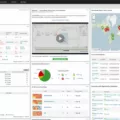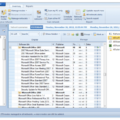In today’s world of technology, one of the most important components of an effective network monitoring system is the use of agentless network monitoring. Agentless network monitoring is a form of network monitoring that allows a monitor to collect performance metrics from devices without having to install any software agents on the devices or servers being monitored. This type of monitoring offers many benefits, such as reducing costs and improving visibility into the performance and status of your network.
Agentless network monitoring works by collecting relevant metrics and sending them to the monitoring platform. This allows for quick and accurate data retrieval, making it much easier for administrators to identify problems before they become too severe. It also makes it easier to troubleshoot any issues that do arise, as the data gathered can often pinpoint exactly where an issue lies.
There are four main types of agentless network monitoring: availability monitoring, configuration monitoring, performance monitoring, and cloud infrastructure monitoring. Availability monitoring is used to determine if a device is up and operational. Configuration monitoring focuses on making sure all configurations are correct and up-to-date. Performance monitoring ensures everything is functioning as expected, while cloud infrastructure monitors how resources are being used in the cloud environment.
Using agentless network monitors provides many advantages over traditional agents. For starters, it reduces costs associated with installing and maintaining agents on each device or server being monitored. It also provides better visibility into your entire network infrastructure so you can quickly identify any potential issues before they cause serious damage or downtime. Finally, since there is no software installed on each device, it eliminates the need for time-consuming updates or patches that need to be applied periodically to keep things running smoothly.
Agentless network monitors are a great option for organizations looking to keep tabs on their networks without having to invest in costly software agents or maintenance fees associated with them. They provide quick access to data that can be used to troubleshoot any issues quickly and accurately while also providing better visibility into your entire infrastructure so you can identify potential problems before they become too severe. Agentless network monitors are a great way to save money while still ensuring your networks run efficiently and effectively!

The Benefits of Agentless Network Monitoring
Agentless network monitoring is a type of network monitoring that utilizes specialized software to collect performance metrics from devices without the need for a software agent to be installed on the monitored devices or servers. Instead, it uses protocols like SNMP, WMI, and SSH to remotely query the device for metrics. This allows administrators to quickly check the status of a device or server without additional setup, reducing the time and cost associated with traditional agent-based monitoring solutions. Agentless network monitoring also helps reduce the load on monitored devices, as there is no additional software installed that could potentially cause system slowdowns or other issues. Additionally, since there is no need for an agent to be installed on the monitored device, it eliminates any security concerns about allowing a third-party application access to your internal systems.
Difference Between Agent and Agentless Network Monitoring
Agent-based network monitoring involves the installation of software on devices in order to collect metrics that are then sent to a monitoring platform. This type of monitoring requires manual intervention, as an agent must be installed on each device that needs to be monitored. On the other hand, agentless network monitoring involves the use of remote probes or scripts that can access devices over the network and collect data without requiring any additional software to be installed on them. This allows for more efficient and automated monitoring but may require additional configuration in order to access certain devices.
Benefits of Agentless Monitoring for Applications
Agentless monitoring is best used when you need to monitor an application but doesn’t have access to the web server or are unable to install OneAgent. It can be helpful when you need to monitor a system that is in a remote location, or if you don’t want the overhead of installing a monitoring agent. Agentless monitoring can also be useful in multi-cloud environments, where managing a single agent across multiple servers can be difficult. You should also consider using agentless monitoring if your application is running on a platform that isn’t supported by OneAgent.
Benefits of Agentless Monitoring
Agentless monitoring offers several distinct advantages over traditional agent-based monitoring. The primary benefit is that it doesn’t require the installation of any agents or software on the monitored systems, which eliminates the need to manage and maintain agents in order to keep them up-to-date and secure. Additionally, since it doesn’t involve any code being installed on target systems, agentless monitoring can be used to monitor and analyze systems without making any changes to them. This makes it ideal for environments where changes are not allowed or when you want to quickly assess the current state of a system without having to worry about installing anything on it. Furthermore, because no agents are required, your monitored systems don’t have to be managed or configured specifically for monitoring purposes, so setup time is greatly reduced. Finally, since no additional components are needed for agentless monitoring, costs associated with hardware upgrades and software licenses can also be avoided.
Reasons for Choosing Agentless Monitoring
Agentless monitoring provides many advantages over traditional agent-based monitoring. Firstly, it is much simpler and easier to deploy and maintain. Unlike agents, which require manual installation, agentless monitoring can be deployed quickly and does not require additional software or hardware to be installed on the target system. This makes it much easier to set up and maintain, as well as reduces the risk of introducing security vulnerabilities caused by installing unknown software on a system.
Secondly, agentless monitoring is more secure than traditional agents. As no software needs to be installed on the target system, there is no risk of malicious code being injected into the environment. This can reduce the risk of data breaches and other malicious activity caused by malicious code being installed on a system.
Finally, agentless monitoring can provide more detailed and accurate metrics than agents. As no software needs to be installed on the target system, agentless monitoring can collect a greater range of metrics from a wider range of sources without having to manually configure each source individually. This means administrators can get a more complete view of their environment without having to spend time configuring individual systems.
Common Tools Used for Network Monitoring
The most common tool used for network monitoring is SNMP (Simple Network Management Protocol). SNMP is a widely-used protocol for monitoring networks, and it is used by almost all network management systems. It can be used to collect data from managed devices such as routers, switches, and firewalls, and also to monitor performance and alert administrators when problems occur. SNMP can be used to poll devices (the monitoring station queries the device) or receive notifications (the device sends an SNMP trap or inform the monitoring station). SNMP is easy to configure and manage, making it the most popular choice for network monitoring.
Conclusion
In conclusion, agentless network monitoring is a powerful tool for IT professionals and network engineers to keep their networks running smoothly. It provides an efficient way to monitor equipment without having to install extra software and it offers different categories of network monitoring such as availability, configuration, performance, and cloud infrastructure monitoring. Agentless monitoring is also great for situations where you don’t have access to the web server and can’t install OneAgent. The ability to monitor networks without needing extra software makes agentless monitoring a great choice for any IT professional.








